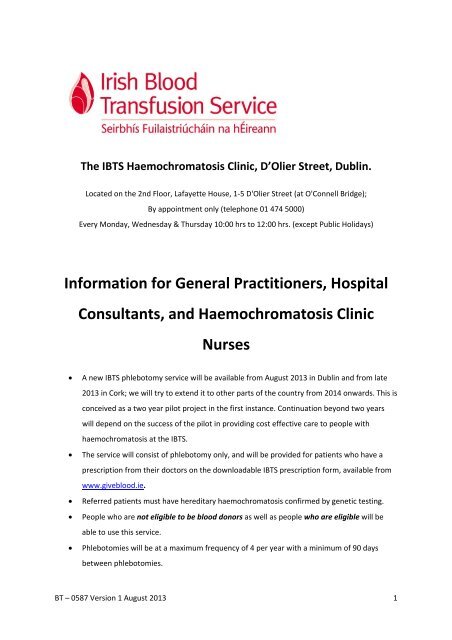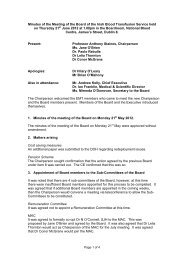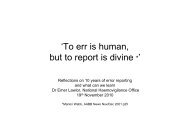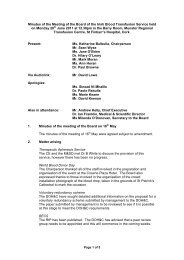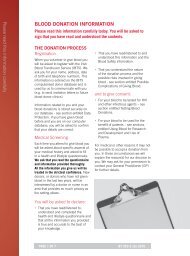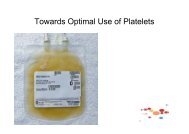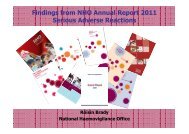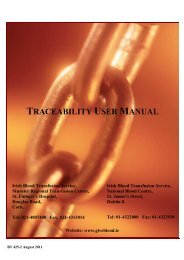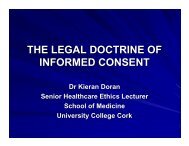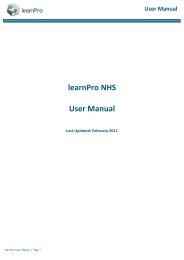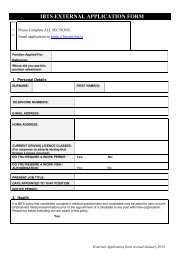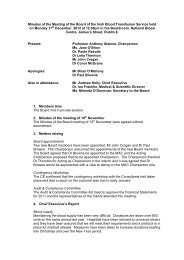Information for GPs - Irish Blood Transfusion Service
Information for GPs - Irish Blood Transfusion Service
Information for GPs - Irish Blood Transfusion Service
You also want an ePaper? Increase the reach of your titles
YUMPU automatically turns print PDFs into web optimized ePapers that Google loves.
The IBTS Haemochromatosis Clinic, D’Olier Street, Dublin.Located on the 2nd Floor, Lafayette House, 1‐5 D'Olier Street (at O'Connell Bridge);By appointment only (telephone 01 474 5000)Every Monday, Wednesday & Thursday 10:00 hrs to 12:00 hrs. (except Public Holidays)<strong>In<strong>for</strong>mation</strong> <strong>for</strong> General Practitioners, HospitalConsultants, and Haemochromatosis ClinicNurses• A new IBTS phlebotomy service will be available from August 2013 in Dublin and from late2013 in Cork; we will try to extend it to other parts of the country from 2014 onwards. This isconceived as a two year pilot project in the first instance. Continuation beyond two yearswill depend on the success of the pilot in providing cost effective care to people withhaemochromatosis at the IBTS.• The service will consist of phlebotomy only, and will be provided <strong>for</strong> patients who have aprescription from their doctors on the downloadable IBTS prescription <strong>for</strong>m, available fromwww.giveblood.ie.• Referred patients must have hereditary haemochromatosis confirmed by genetic testing.• People who are not eligible to be blood donors as well as people who are eligible will beable to use this service.• Phlebotomies will be at a maximum frequency of 4 per year with a minimum of 90 daysbetween phlebotomies.BT – 0587 Version 1 August 2013 1
• We will not take blood samples <strong>for</strong> iron status or other investigations related tohaemochromatosis.• Patients must have undergone initial “de‐ironing” as necessary, and the plasma ferritin levelmust be lower than 600 µg/L be<strong>for</strong>e referral to the IBTS.• Patients must have no complications of haemochromatosis or other conditions that needfollow up by their GP/Consultant more than once a year, other than stable andstraight<strong>for</strong>ward conditions such as uncomplicated hypertension under therapeutic control,non‐insulin dependent diabetes being treated by oral medication, i.e. oral hypoglycaemics,simple skin disorders or similar.• The treatment will be by appointment only at the clinics in D’Olier Street in Dublin and StFinbarr’s Hospital in Cork.• We ask you not to send us patients who are known to be positive <strong>for</strong> transfusiontransmissible diseases (HIV, hepatitis B or hepatitis C), or who are known active drug usersor sex workers. While we all accept the risk that patients may transmit infections fromaccidental blood exposures, the level of blood exposure risk in therapeutic phlebotomieswarrants this extra degree of protection <strong>for</strong> the blood transfusion environment.• We also ask you not to send us patients who have difficult venous access <strong>for</strong> phlebotomy orwho do not tolerate 470 ml phlebotomies – we do not have the capability to providealternatives to full 470 ml phlebotomies in our clinics.• We reserve the right to refuse treatment to patients who are disruptive or who act in anyway that may be considered a threat to safety or supply of blood <strong>for</strong> transfusion. In additionwe will refer repeatedly non‐attending patients back to the referring physician.How will it work?1. People with hereditary haemochromatosis, who in the opinion of their own doctor requirephlebotomy, get a prescription from their doctor on the downloadable IBTS prescription<strong>for</strong>m <strong>for</strong> up to 4 x 470ml phlebotomies per year.The prescription can be renewed annually as required, but a maximum of one year’streatment is allowed per prescription.2. The patient makes an appointment with the IBTS <strong>for</strong> an initial visit to one of the two clinics –Dublin & Cork. The maximum waiting <strong>for</strong> the first visit will be three months, and should be alot shorter than that.BT – 0587 Version 1 August 2013 2
3. At the first visit the patient gets a therapeutic phlebotomy, and is assessed <strong>for</strong> willingnessand eligibility to become a blood donor.If willing and eligible, the patient undergoes a donor interview, and is tested <strong>for</strong> transfusiontransmissible diseases, and <strong>for</strong> blood group, in the same way as all donors.The donor is thereafter treated at the blood donor sessions at D’Olier Street and St Finbarr’s.4. If the patient doesn’t want to be a blood donor, or isn’t eligible to be one, then he or she cancontinue to come to the D’Olier Street/St Finbarr’s haemochromatosis clinics <strong>for</strong> treatment.5. All treatment is free, regardless of insurance status or medical card status – we will notcollect that in<strong>for</strong>mation.6. At each attendance we will check your patient’s haemoglobin level in the finger pulp vessels.The cut off level <strong>for</strong> therapeutic phlebotomy is 110 g/L; <strong>for</strong> donation <strong>for</strong> transfusionpurposes it is higher by law – 135 g/L <strong>for</strong> men and 125g/L <strong>for</strong> women. Finger pulphaemoglobin levels can vary from venous levels <strong>for</strong> several reasons – some physiological,some artefactual, but they serve our purposes well <strong>for</strong> the most part. If we have torepeatedly reject your patient because of low levels we will ask them to return to you <strong>for</strong>further management.Data, data protection, and communicationAll interactions with patients and donors will be logged on the IBTS computer and all records will bemaintained in accordance with all relevant legislation.There will be no paper record kept at the IBTS. The prescription <strong>for</strong>m will be annotated with a recordof the success or otherwise of each phlebotomy event, and returned to the patient <strong>for</strong> theirsafekeeping.The IBTS provides an after‐donation service to advise donors who develop problems after blooddonation – faints, bruising, pain in the arm. This service will also be available to patients withhaemochromatosis, but we will not otherwise be in a position to provide advice and service aboutthe management of their haemochromatosis. This will remain the responsibility of their own doctor.BT – 0587 Version 1 August 2013 3
Similarly, we will not provide a telephone follow‐up service, or a separate reporting service, <strong>for</strong>doctors who have provided prescriptions <strong>for</strong> patients – the costs <strong>for</strong> this are too high <strong>for</strong> us. We willreply to correspondence within our usual timeframes, and duty medical staff are available at alltimes, 24/7/365, <strong>for</strong> urgent matters.What if……My patient doesn’t want to travel to Dublin or Cork – can’t he or she go to a local blood donationclinic?Not at this point. Otherwise your patient has a real financial incentive (the cost and inconvenience oftravel) to withhold in<strong>for</strong>mation that would result in being rejected at the local blood donation clinic,although they would be welcome at the Dublin/Cork clinics <strong>for</strong> treatment. This is not to impugn theintegrity of any individual, but the literature is compelling that even apparently small incentivesundermine the overall safety of blood transfusion over time.My patient has HIV, Hep C or Hep B?We ask that you do not refer these patients to us. We won’t be checking the virus status in patientswho don’t want to donate <strong>for</strong> transfusion purposes, and while we all accept the risk that patientsmay transmit infections from accidental blood exposures, the level of blood exposure risk intherapeutic phlebotomies warrants this extra degree of protection <strong>for</strong> the blood donationenvironment.My patient is a man who has sex with men, but doesn’t want to discuss it with or tell the IBTS?That’s fine. As long as your patient opts to have therapeutic phlebotomies only, and indicates thathe doesn’t want to be considered <strong>for</strong> donation <strong>for</strong> transfusion purposes, he is under no obligation todiscuss the reasons <strong>for</strong> his choice with us. We can expect that there will be some resentmentexpressed by some men over our exclusion‐from‐donation policy, but as things stand that policyremains in <strong>for</strong>ce.My patient has poor veins?We will not be able to use alternative approaches, such as needle and syringe, or paediatriccollection devices, or red cell apheresis devices, at least <strong>for</strong> the time being. So if your patient isn’tBT – 0587 Version 1 August 2013 4
going to be suitable <strong>for</strong> phlebotomy using the standard blood donation equipment (16 gauge needleand 470 ml pack), we ask you not to send them to us.My patient doesn’t tolerate full volume phlebotomies?Same as above.My patient has been going to blood donor clinics, using the IBTS <strong>for</strong> treatment of haemochromatosis,without mentioning they have haemochromatosis?They shouldn’t. The practice of surreptitiously using the IBTS <strong>for</strong> treatment of haemochromatosis toavoid inconvenience or costs undermines the principle of donating entirely <strong>for</strong> altruistic reasons.Donating <strong>for</strong> altruistic reasons only is firmly established as providing the maximum safety <strong>for</strong>patients needing transfusions. Concealing a non‐altruistic motive, and abetting that practice, isdeceitful and potentially dangerous. Medical practitioners should never support such practice.However, if a current blood donor is found to have haemochromatosis, we allow them to continuedonating up to four times a year when their serum ferritin is within the physiological range andprovided they are free from other reasons <strong>for</strong> deferral. This isn’t a perfect solution, and this newpolicy goes some way towards addressing the issues around this.This service may well reveal that some people have in the past donated blood <strong>for</strong> treatment ofhaemochromatosis but have withheld important in<strong>for</strong>mation that would have prevented them frombeing donors – <strong>for</strong> example living in the UK between 1980 and 1996, or, being male havingpreviously had sex with men.The IBTS has well worked out protocols to deal with in<strong>for</strong>mation like this emerging some time afterdonations have been given. The recipients of previous donations are followed up appropriately,while the donor’s anonymity is protected.My patient doesn’t need to have a venesection more than a couple of times per year?We will provide as many phlebotomies as you prescribe, up to a maximum of four per annum.My patient needs more than 4 phlebotomies per year.We will only provide up to a maximum of four per year, with a minimum of 90 days betweenphlebotomies. We cannot easily and cheaply apply a different set of standards at this point.However the patient may have phlebotomies at other clinics in the intervening periods if necessarywithout impacting on their treatment at the IBTS clinics.BT – 0587 Version 1 August 2013 5
When will…..This service start?The phlebotomy service will begin in August in Dublin, and in Cork in late 2013. We will start takingbookings from 16 th of July 2013 <strong>for</strong> phlebotomy at the Dublin clinic from August onwards. Patientscan call 01 474 5000 from that date to make an appointment.Start times in Cork will be advised nearer the time in the autumn.The service extend to other regions?We will do our best to get it running in Limerick, Galway and the North East within a year. We haveto work out the real costs in areas where we do not have a current fixed clinic, based on theexperience of the clinics in Dublin and Cork, and ensure a robust funding model.Further questions? Please call or text Dr William Murphy on 0872319442, or (preferably) email him on nmd@indigo.ie.BT – 0587 Version 1 August 2013 6


